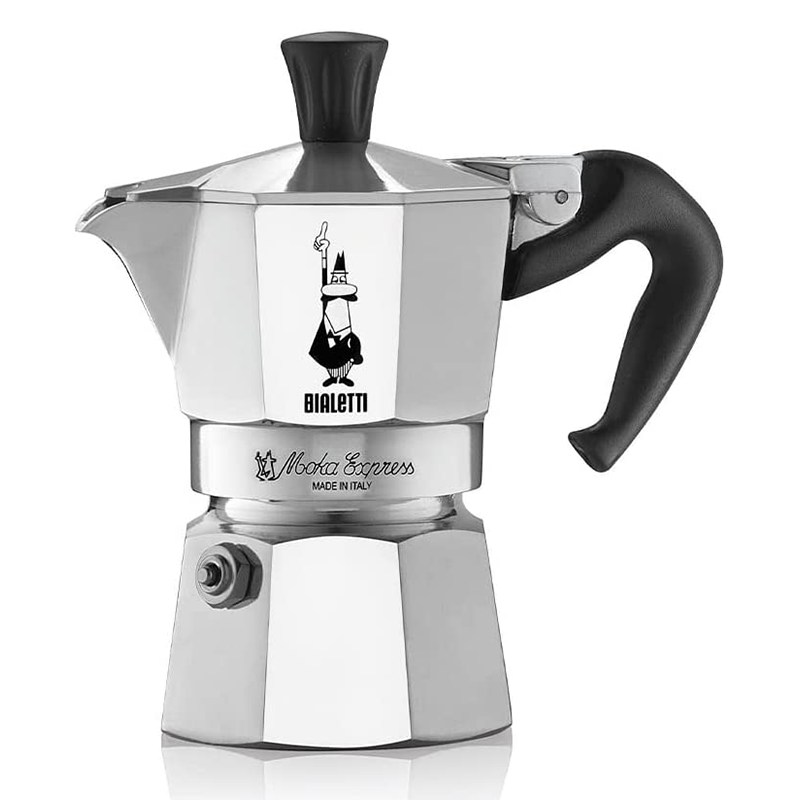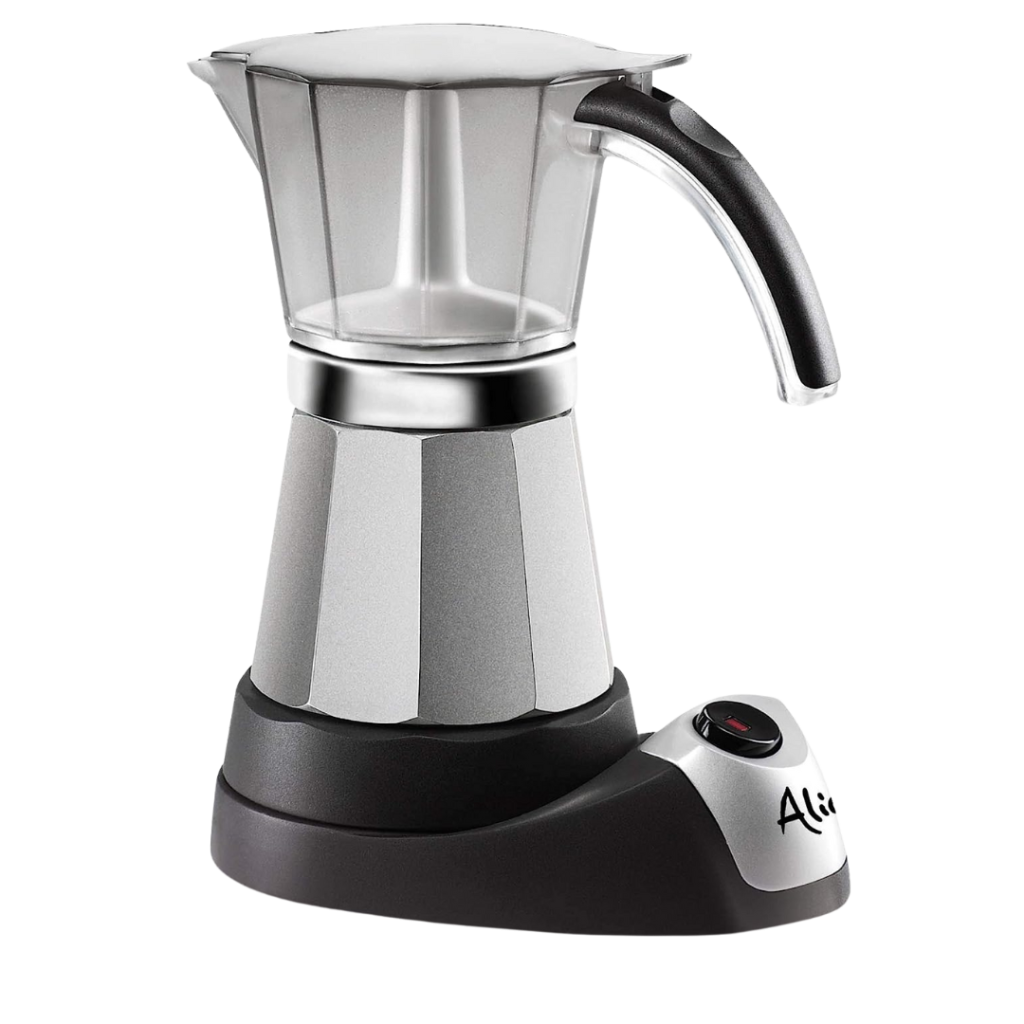Find the answer to “How many cups does a moka pot make?” and other moka pot-related questions.
A moka pot has five different sizes. Typical sizes include 1, 3, 6, 9, and 12 cups. Obviously, a larger Moka Pot makes more coffee. However, coffee enthusiasts prefer the 3-cup moka pot.
What is a moka pot?
The first Moka pots appeared in Italy in the 1930s. Mocha comes from the Yemeni city of Mocha, a coffee mecca for generations.
The coffee culture of the time centered on coffeehouses, where the beverage was brewed and consumed. Alfonso Bialetti, an Italian engineer and aluminum metalworker, designed the moka pot as a cheap and easy way to make coffee at home.
The Moka Express Bialetti invented is the most widely available and well-known model of moka pot on the market today. Art deco buildings and 1930s fashion served as inspiration for the design.
Each moka pot has a bottom chamber (the cylinder), a filter funnel, and a collection chamber (the top chamber) with a second detachable filter kept in place by a rubber gasket.
The Cuban community is responsible for most moka pot sales outside of Europe. For the traditional Cuban beverage, café cubano, sugar is mixed into the initial dribbles of coffee before adding the remainder of the pot. In Cuba, the iconic Moka Express moka pot known as a cafetera is ubiquitous in every home.
Caffe cubano is an all-day affair, not just for when you wake up.
Add some milk to it in the morning, and you’ve got yourself a delicious cup of café con leche. You can have it again in the afternoon, after lunch, and once more at coffee hour, around three or four. Some Cubans habitually chug a tiny cup of coffee every hour on the dot.
What size moka pot to get?
The most common size I’ve seen for moka pots is a 6-cup capacity. It yields between 8 and 10 ounces, depending on how much water the grinds take up.
Initially, the Moka Express line only included a 3-cup pot, perfect for a single individual or a small family. The company offers a wide range today, from the tiny half-cup Mokina, which only holds enough for a single 1.5-ounce shot of coffee, to the massive 18-cup Moka Express. Sadly, the 50-cup model is for decorative purposes only and not for use.
Think about the number of people in your home, how much coffee they consume daily, and — most importantly — how much caffeine they can handle when deciding what size moka pot to get.
A moka pot serves a far more concentrated beverage in a much smaller volume than a pour-over. If you like your lattes on the stronger side and can tolerate the caffeine, a 6-cup moka pot should be just right for two servings.
For a quick afternoon pick-me-up, my go-to has been a moka pot that makes just one cup at a time. It’s compact, like a shot of espresso, but with less caffeine overall than a pour-over and a thick, rich texture that won’t leave you wanting more.
Is Moka coffee as strong as espresso?
The coffee I prepare in a moka pot tastes similar to espresso, so I treat it as such. I add milk to make a fake cortado or a latte, but it’s not the same. While moka coffee benefits from some enrichment, espresso stands on its own.
“Do moka pots make espresso?” is a common question, next to “How many cups does a moka pot make?” The answer is “No.”
Espresso has a stronger flavor and a greater body than moka coffee. Espresso has an ineffable “syrupiness” that the moka pot can’t achieve.
Moka pots may be called “stovetop espresso makers,” but they don’t make authentic espresso. The pressure to make coffee in a moka pot is more than the average person can produce by hand. But only about 1 to 2 bars. The best bar pressure for espresso is nine.
How to make coffee in a moka pot?
Here’s how to make coffee in a moka pot:
- Pour boiling water into the base up to the steam valve. The Bialetti handbook recommends starting with cold water, But this increases the chance of burning the coffee, as it will be exposed to heat for a longer period.
- Put roughly three-quarters of a cup’s worth of finely ground coffee (20 grams for a 6-cup moka pot) into the filter. Set it into the bottom of the pot.
- Screw the top on. Be careful if you use already-boiled water, as the base will be pretty hot.
- Place it on a stovetop burner. I use the highest setting on my tiniest burner, But you may need to experiment with the heat level to achieve the desired result. Otherwise, the coffee may turn out bitter.
- Let the coffee rise to the top chamber and begin to bubble. There should be a gurgling noise when the upper chamber is about halfway full of coffee. The unmistakable sound implies steam has forced all the water through the coffee grounds and into the top chamber, making the coffee ready to drink.
- Quickly pour the coffee from the moka pot. A better option is to chill the bottom chamber by running cold water through it, preventing the coffee from burning and turning bitter.
Can I use pre-ground coffee in moka pot?
Using standard pre-ground coffee, you can make delicious coffee in a moka pot.
You can use any bean and grind it to any degree you like. The two factors might have a significant effect on the flavor of your coffee.
Coffees from Central or South America tend to be medium or darker roasted and packed with chocolate and toasted nutty overtones. They transfer particularly well in a moka pot and are the closest to the profiles historically favored in Italy.
But I like to use a lightly roasted bean that still has a lot of flavor. If you enjoy trying new things, a moka pot is a great way to get to know your favorite coffee in a new light.
If you prefer a rougher grind, try grinding your beans longer than you would for granulated sugar. You can also tweak it to suit your palate. You can try brewing the coffee with coarsely ground beans if it turns out too bitter or takes too long to boil. It has to be ground finer if the flavor is poor or bland.
If you want to make authentic café cubano, I recommend Café Bustelo, a finely ground coffee widely available in Cuba.
There’s a touch of art involved in making moka coffee. Over time, you’ll have the confidence to trust your gut rather than a coffee scale.
Our moka pot recommendations
The Moka Pot makes excellent coffee, but purchasing the correct pot will make it even better. Choices like material and size are entirely up to you and your needs and preferences.
Remember that most moka pots are stainless steel or aluminum. Although stainless steel takes longer to heat up and is heavier than aluminum, it offers many advantages. Stainless steel outlasts aluminum, is more aesthetically pleasing, and is less likely to rust or corrode.
Coffee becomes stuck in the aluminum’s pores and is difficult to remove entirely. Not many people fuss about this, but you should consider it. But aluminum leaching into the drink may be of concern to some. A stainless steel pot will be ideal if you fit this description.
Finally, stainless steel is pricey. Therefore, an aluminum moka pot is perfect if you want cheap brewing gear.
How about choosing between a stovetop or an electric moka pot?
Stovetop moka pots are more durable than electric models. But large burners are standard on modern electric stoves. Even the smallest size is too big for a moka pot. Therefore, an electric Moka pot is ideal in this regard.
You can use an electric moka pot anywhere, even without a stovetop. The only thing you’ll need is access to a power outlet. But while the convenience of electric moka pots is undeniable, they are also more likely to break and require replacement.
Bialetti Moka Express

Bialetti Moka Express is a stovetop icon for a reason. It brews a rich, potent coffee that jolts the senses. But it’s also about the ritual. The gurgle of the pot, the careful pour into your favorite mug – a moment of mindfulness woven into your day.
The Moka Express combines affordability with a modern design and practical simplicity.
Regular espresso machines can cost hundreds of dollars or more; using them takes some experience. But the moka express is incredibly user-friendly. It’s also forgiving; the worst you can do is burn your coffee.
The coffee it makes has a more robust flavor than that of a French press or a drip coffee machine. The pot’s side is adorned with a sleepy-eyed little man with a mustache, reminding you that you’re using a tried-and-true Italian invention.
Delonghi EMK6 Alicia Moka Espresso Maker

The Delonghi EMK6 Alicia Moka Espresso Maker has a 30-minute warming function and can brew coffee for three to six standard mugs. This model’s sole drawback is that you can’t use it on a stovetop.
If you’re looking for something simple, the Delonghi EMK6 is your best bet.
Alicia is unlike other stovetop espresso makers because it is portable. You can use it anywhere an electrical outlet is available.
With Alicia, you can watch the brewing process in action thanks to the top’s transparent, heat-resistant plastic top. The brew basket has a built-in automatic shut-off, so the coffee will never overflow or be over-extracted.
Cuisinox Roma Stainless Steel Coffee Maker
Coffee brewed in a Cuisinox Roma only takes four to five minutes to brew, and it tastes fantastic. Although its stainless steel frame is undoubtedly eye-catching, it’s not the most remarkable aspect. The design is so sturdy that it comes with a limited 25-year warranty. It is evidence of the manufacturer’s faith in the quality of the product.
Cuisinox Roma stands out as a safe option for those concerned about aluminum leaching in a market where aluminum pots predominate.
This coffee maker’s variety allows the simultaneous production of 4, 6, or 10 cups. You can, however, choose to brew less if you prefer.
It is compatible with electric, gas, ceramic, and halogen stoves. The only thing to remember is that the burner must be smaller than the Roma.
The lack of insulating material in the model’s handle is its sole drawback. This Moka pot is also more expensive because of its costly material.
Some people are starting to ignore the moka pot in favor of newer developments. But I love its simplicity and nostalgic charm unrivaled by other coffee makers.
A 3-cup moka pot will forever be in my kitchen.
